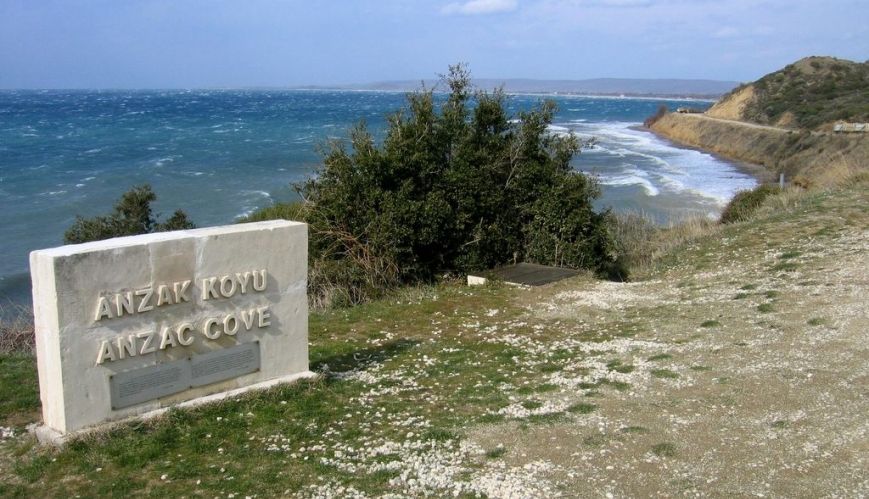From Anzac Cove to Calvary

From Anzac Cove to Calvary
25 April 2019
There is much that links Anzac Day and Easter Sunday together.
A handful of years ago, I stood in the early morning light of a brilliantly clear day above the aqua waters at Anzac Cove, the stillness and rugged beauty of the place somehow making a fitting contrast to the blood-soaked soil we all know it once to have been.
Around me were scores of young Australians whose backpacking adventures had drawn them to the hostels of the Gallipoli peninsula. On that sparkling morning a spell appeared to come over the crowd as all became silent before the memorials and graves carrying disturbingly familiar-sounding names in such a foreign and faraway place.
Most found somewhere to wander silently on their own, swallowing hard and wiping away tears. It was an extraordinary thing to witness. This year, due to a quirk of the calendar and moon, Anzac Day fittingly follows quickly after Easter Sunday.
There is much that links these days and ties them together. Both Anzac Day and Easter are rich in a deeply embedded symbolism, evoking the gravity of what is being remembered, and the tradition that it seeks to pass on.
Both events have their sceptics and revisionist historians who scoff at what they see as lavish and contrived myths. And the truth is that many regard both these marks on the calendar as nothing more than a good excuse for a holiday.
The connections don’t stop there. Both days emerge from a story and a past that, for many, has the power to tell us who we are.
The Good Friday part of Easter shares with 25 April the darkness of political betrayal, treachery, dashed hopes, young life cut short; more of a sense of the absence of God than his presence. Soldiers who have known the hell of war can relate more than most to the desolate ‘Good Friday’ cry from the cross that the Gospels report Jesus to have exclaimed, “My God, My God, why have you forsaken me?”
The Anzac and Easter stories both have that much sought after quality that connects us to something larger and grander than ourselves. Both tell of the ultimate sacrifice – the giving of a life for another.
War memorials are frequently adorned with the old King James Version of John 15:13: “Greater love hath no man than this, that a man lay down his life for his friends.” Also held in common is the fear especially among older generations that the story will be lost, that we somehow need to cling to it but don’t know how.
Yet strangely, the young seem not to have abandoned the commemoration of Anzac Day. Dawn services will again be filled with all ages this year, but will the same be true of churches this Easter?
Biblical scholar and former Bishop of Durham Tom Wright argues that hunger for spirituality remains a driver for Westerners, although these days it manifests itself in many and varied ways. He suggests that spirituality is like a hidden spring bubbling up from beneath and penetrating the materialism of the West that has dominated thinking for so long. Is this partly what we see played out on Anzac Day?
Australian social commentator Hugh Mackay would agree with Wright. Mackay’s book, The Ten Desires That Drive Us, identified the “desire for something to believe in” as key.
“Regardless of debates about the possible meanings of ‘God’,” says Mackay, “and regardless of the ever-expanding range and variety of religious faith and practice, the underlying truth is inescapable: there is a powerful human desire to believe in something in the realm of the non-material.”
It’s this ‘non-material’ element of life that still has power to stop us in our tracks before something of tragic beauty like a sacred battlefield. It’s the indefinable quality that can compel some of us to get out of bed before dawn to attend sunrise services.
And the claims of Easter Sunday, for those who still take them seriously, remain a powerful balm to the jolting finality of standing before a human grave – whether it be at Lone Pine, or Pozieres, or Fromelles, or closer to home.
Somewhere behind the chocolate eggs and hot cross buns remains the strange and ancient account of a resurrection; the glimmer of hope that death is not the end of the story.
It’s this hope that’s easily seen on the ageing gravestones at Gallipoli: “Our dear son who lost his life to find it,” says one. “Not goodbye but goodnight,” suggests another.
For millions around the world, it’s the enduring hope of Easter morning that adds rich meaning to all our joys and sorrows, including whatever it is that brings a lump to our throat at the sound of the Last Post come Anzac Day morning.
Simon Smart is Executive Director of the Centre for Public Christianity. This is an edited version of an article that also appeared in The Weekend Australian.